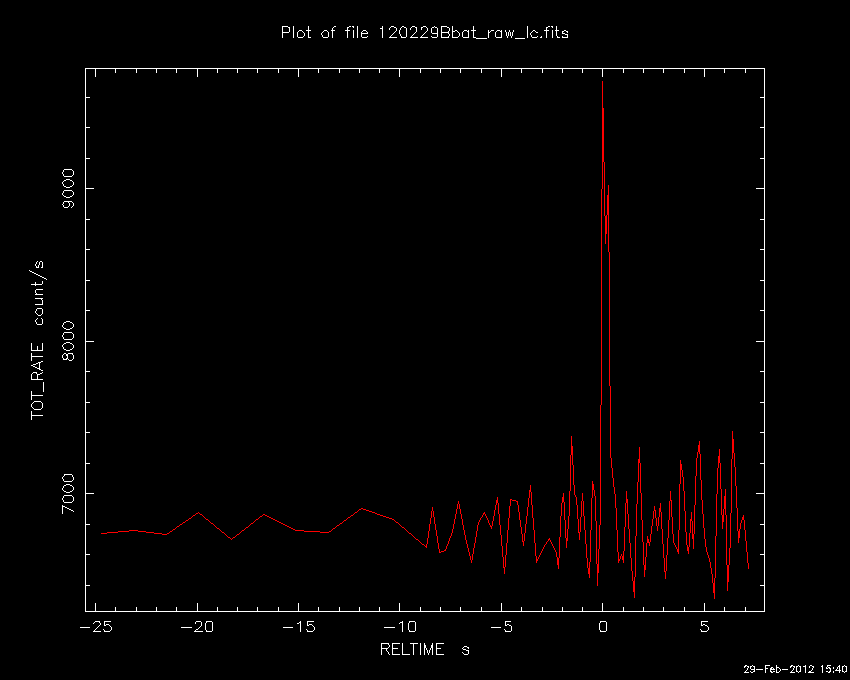(All information courtesy of the instrument teams.)
![]() Previous IAU Circulars
Previous IAU Circulars
TITLE: GCN/SWIFT NOTICE
NOTICE_DATE: Wed 29 Feb 12 14:35:36 UT
NOTICE_TYPE: Swift-BAT GRB Position
TRIGGER_NUM: 516571, Seg_Num: 0
GRB_RA: 20.035d {+01h 20m 08s} (J2000),
20.174d {+01h 20m 42s} (current),
19.463d {+01h 17m 51s} (1950)
GRB_DEC: -35.807d {-35d 48' 26"} (J2000),
-35.744d {-35d 44' 37"} (current),
-36.070d {-36d 04' 09"} (1950)
GRB_ERROR: 3.00 [arcmin radius, statistical only]
GRB_INTEN: 1488 [cnts] Image_Peak=144 [image_cnts]
TRIGGER_DUR: 0.256 [sec]
TRIGGER_INDEX: 123 E_range: 25-100 keV
BKG_INTEN: 27819 [cnts]
BKG_TIME: 52496.05 SOD {14:34:56.05} UT
BKG_DUR: 8 [sec]
GRB_DATE: 15986 TJD; 60 DOY; 12/02/29
GRB_TIME: 52511.16 SOD {14:35:11.16} UT
GRB_PHI: -150.25 [deg]
GRB_THETA: 25.89 [deg]
SOLN_STATUS: 0x3
RATE_SIGNIF: 19.69 [sigma]
IMAGE_SIGNIF: 9.66 [sigma]
MERIT_PARAMS: +1 +0 +0 -2 +2 +0 -100 +0 -71 +0
SUN_POSTN: 341.92d {+22h 47m 40s} -7.66d {-07d 39' 45"}
SUN_DIST: 44.80 [deg] Sun_angle= -2.6 [hr] (East of Sun)
MOON_POSTN: 63.46d {+04h 13m 50s} +21.54d {+21d 32' 37"}
MOON_DIST: 70.42 [deg]
MOON_ILLUM: 46 [%]
GAL_COORDS: 269.56,-79.39 [deg] galactic lon,lat of the burst (or transient)
ECL_COORDS: 1.67,-40.34 [deg] ecliptic lon,lat of the burst (or transient)
COMMENTS: SWIFT-BAT GRB Coordinates.
COMMENTS: This is a rate trigger.
COMMENTS: A point_source was found.
COMMENTS: This does not match any source in the on-board catalog.
COMMENTS: This does not match any source in the ground catalog.
COMMENTS: This is a GRB.
COMMENTS: This trigger occurred at longitude,latitude = 9.87,14.60 [deg].

TITLE: GCN/SWIFT NOTICE
NOTICE_DATE: Wed 29 Feb 12 14:40:36 UT
NOTICE_TYPE: Swift-BAT GRB Lightcurve
TRIGGER_NUM: 9085451, Seg_Num: 6
GRB_RA: 20.035d {+01h 20m 08s} (J2000),
20.174d {+01h 20m 42s} (current),
19.463d {+01h 17m 51s} (1950)
GRB_DEC: -35.807d {-35d 48' 26"} (J2000),
-35.744d {-35d 44' 37"} (current),
-36.070d {-36d 04' 09"} (1950)
GRB_DATE: 15986 TJD; 60 DOY; 12/02/29
GRB_TIME: 52511.16 SOD {14:35:11.16} UT
TRIGGER_INDEX: 123
GRB_PHI: -150.25 [deg]
GRB_THETA: 25.89 [deg]
DELTA_TIME: -2690.00 [sec]
TRIGGER_DUR: 0.256 [sec]
SOLN_STATUS: 0x3
RATE_SIGNIF: 0.00 [sigma]
IMAGE_SIGNIF: 0.00 [sigma]
LC_URL: sw00516571000msb.lc
SUN_POSTN: 341.92d {+22h 47m 41s} -7.66d {-07d 39' 40"}
SUN_DIST: 44.80 [deg] Sun_angle= -2.6 [hr] (East of Sun)
MOON_POSTN: 63.50d {+04h 14m 01s} +21.55d {+21d 32' 51"}
MOON_DIST: 70.45 [deg]
MOON_ILLUM: 46 [%]
GAL_COORDS: 269.56,-79.39 [deg] galactic lon,lat of the burst (or transient)
ECL_COORDS: 1.67,-40.34 [deg] ecliptic lon,lat of the burst (or transient)
COMMENTS: SWIFT-BAT GRB Lightcurve.
COMMENTS:
COMMENTS: WARNING: No BAT_Position TDRSS message was received for this trigger_number!
COMMENTS:
COMMENTS:
COMMENTS: The next comments were copied from the BAT_POS Notice:
COMMENTS: This is a rate trigger.
COMMENTS: A point_source was found.
COMMENTS: This does not match any source in the on-board catalog.
COMMENTS: This does not match any source in the ground catalog.
COMMENTS: This is a GRB.
COMMENTS: This trigger occurred at longitude,latitude = 9.87,14.60 [deg].
COMMENTS: The 3rd packet (of 3) was missing in the lightcurve data stream.

RA(J2000) = 01h 20m 08s Dec(J2000) = -35d 48' 26"with an uncertainty of 3 arcmin (radius, 90% containment, including systematic uncertainty). The BAT light curve showed a single short peak structure with a duration of about 0.5 sec. The peak count rate was ~3000 counts/sec (15-350 keV), at ~0 sec after the trigger.
RA(J2000) = 01h 20m 07.9s
Dec(J2000) = -35d 47' 44.0"
with an uncertainty of 1.9 arcmin, (radius, sys+stat, 90% containment).
The partial coding was 85%.